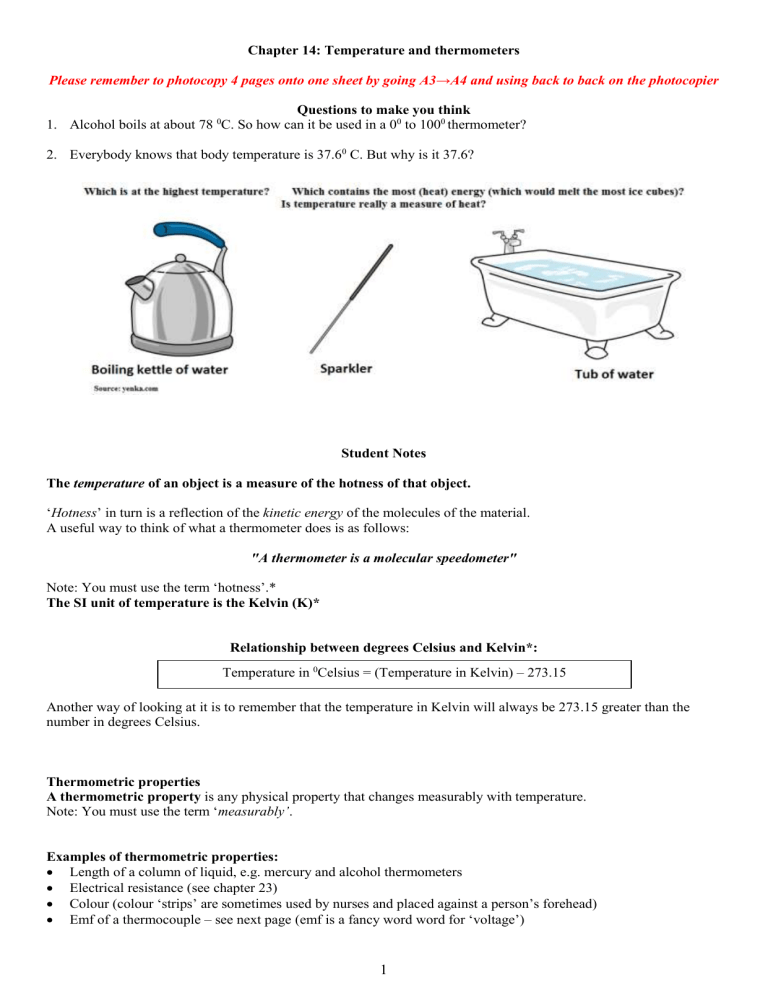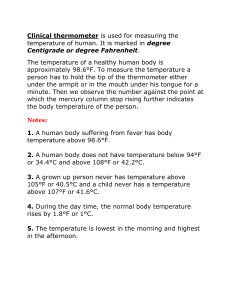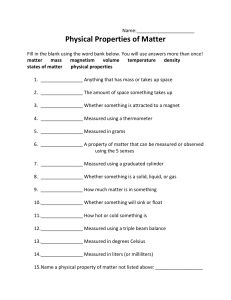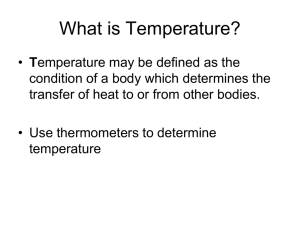
Chapter 14: Temperature and thermometers
Please remember to photocopy 4 pages onto one sheet by going A3→A4 and using back to back on the photocopier
Questions to make you think
1. Alcohol boils at about 78 0C. So how can it be used in a 00 to 1000 thermometer?
2. Everybody knows that body temperature is 37.60 C. But why is it 37.6?
Student Notes
The temperature of an object is a measure of the hotness of that object.
‘Hotness’ in turn is a reflection of the kinetic energy of the molecules of the material.
A useful way to think of what a thermometer does is as follows:
"A thermometer is a molecular speedometer"
Note: You must use the term ‘hotness’.*
The SI unit of temperature is the Kelvin (K)*
Relationship between degrees Celsius and Kelvin*:
Temperature in 0Celsius = (Temperature in Kelvin) – 273.15
Another way of looking at it is to remember that the temperature in Kelvin will always be 273.15 greater than the
number in degrees Celsius.
Thermometric properties
A thermometric property is any physical property that changes measurably with temperature.
Note: You must use the term ‘measurably’.
Examples of thermometric properties:
Length of a column of liquid, e.g. mercury and alcohol thermometers
Electrical resistance (see chapter 23)
Colour (colour ‘strips’ are sometimes used by nurses and placed against a person’s forehead)
Emf of a thermocouple – see next page (emf is a fancy word word for ‘voltage’)
1
Operation of a thermocouple
A thermocouple is comprised of two different metals joined together at both ends to form two junctions.
One junction is connected to a liquid of known temperature like ice-water which would be at 0 0C; this is
the cold or reference junction.
The other junction is connected to the liquid whose temperature is to be measured.
An emf /voltage is produced (as seen in the diagram).
Increase the temperature of the heat source and note the new temperature (using an existing
thermometer) and new voltage.
Plot a graph of emf against temperature.
You can now use the graph with this thermocouple to establish the temperature of the liquid in the future
(dip the measuring junction into the liquid note the voltage and use the graph to get the corresponding
temperature).
Disagreement between thermometers
Two different types of thermometer will give slightly different readings at the same temperature.*
This means we need to agree on one particular thermometer to have as a standard.
(This is an answer to the common exam question: Why do we need to have a standard thermometer?)
"In the present state of physical science, therefore, a question of extreme interest arises: Is there any principle on
which an absolute thermometric scale can be founded?"
Lord Kelvin
Mandatory Experiment: To plot a calibration curve for a
thermometer using a mercury thermometer as a standard.
The temperature of outer space is 2.7 K.
In 2003 MIT reached 0.00000000045 kelvin, possibly the coldest
temperature ever reached anywhere in the universe.
Did you hear about the scientist who got cooled to absolute zero?
He’s 0K now.
2
Leaving Cert Physics Syllabus
Content
Depth of Treatment
Activities
Concept of
temperature
Measure of hotness or coldness of
a body.
The S.I. unit of temperature is the
Kelvin.
Celsius scale is the practical scale
of temperature.
T /0C = T /K – 273.15
Thermometric
Properties
A physical property that changes
measurably with temperature.
Demonstration of some
thermometric properties:
length of liquid
column, e.g. length
of mercury column
emf of
thermocouple
Pressure of a gas at
constant volume
Volume of a gas at
constant pressure
Resistance
colour
Thermometers
Thermometers measure
temperature.
Two thermometers do not
necessarily give the same reading
at the same temperature.
The need for standard
thermometers – use any
commercial laboratory
thermometer as a school standard.
Graduate two
thermometers at ice and
steam points.
Compare values obtained
for an unknown
temperature, using a
straight-line graph between
the reference points.
3
STS
Practical thermometers,
e.g.
clinical
thermometer
oven thermometers
boiler thermometer
temperature gauge
in a car.
TO CALIBRATE A THERMOMETER USING THE LABORATORY MERCURY THERMOMETER AS A
STANDARD
APPARATUS
Mercury thermometer, unmarked thermometer, heat source, beaker of water, ruler.
DIAGRAM:
PROCEDURE
1. Set up apparatus as shown in the diagram.
2. Record the temperature θ, in °C, from the mercury thermometer and the corresponding length of alcohol in the
blank thermometer.
3. Allow the temperature of the water to increase by about 5 °C.
4. Repeat the procedure until at least ten sets of readings have been recorded.
5. Plot a graph of length l against temperature θ.
6. An unknown temperature can now be determined using the blank thermometer by noting the length of alcohol at
this temperature and then using the graph to calculate the temperature.
RESULTS
Temperature (°C)
Length (cm)
CONCLUSION
When we plotted our results we got a reasonably straight line. We then tested our graph using some lukewarm water.
We got a length of 15cm on the blank thermometer and used the graph to give us a temperature of 56 0C. When we
used the mercury thermometer to check our results we got a temperature of 58 0C so all in all it wasn’t a complete
waste of time. Still though, I have to admit I’ve lived through more exciting events.
SOURCES OF ERROR / PRECAUTIONS
1. Heat the water very slowly so that it is easy to take temperature and length readings simultaneously.
2. Have your eye level with the liquid columns when taking temperature and length readings to avoid parallax error.
2011 Question 7 (c)
Describe how to establish a calibration curve for a thermocouple.
Hold one junction at constant temperature,
Hold the other junction in water beside an (already calibrated) thermometer.
Heat the water (in steps of 10 oC approx) and note temperature and emf values each time.
Plot a graph of emf vs. Temperature.
4
Extra Credit
* You must use the term ‘hotness’
So why can’t we say that “the temperature of an object is a measure of how hot or cold an object is”?
‘Hot’ is a vague term. Does it refer specifically to temperature, or to the amount of heat in the object? After all, a litre
of water at 1000 Celsius has twice as much heat as half a litre of water at 1000 Celsius. ‘Hotness’ is the physicists way
of overcoming this potential confusion.
*The SI unit of temperature is the Kelvin (K)
SI stands for ‘Standard Internationale’ (French). Basically it’s a system of units (incorporating the metric system)
which connects up all the main physical quantities, and which has been agreed by all scientists (but not Engineers,
funnily enough).
For more info on this see http://www.npl.co.uk/reference/
Why is it degrees Celsius, but not degrees Kelvin?
I think it’s because for the Celsius scale one degree corresponds to one hundredth of the temperature difference
between freezing point and boiling point of water (similarly you can divide a circle up into 360 degrees). But the
Kelvin temperature scale is not defined in this way; it just has a baseline and then increases - hence no degrees .
*Relationship between celsius and kelvin and absolute zero
What’s significant about 273.15?
Well, temperature is really a measure how quickly atoms or molecules in an object are moving or vibrating; the colder
the temperature the more sluggish the molecules move. Now, taking this to the extreme, scientists have calculated that
these atoms would cease moving if the temperature dropped as low as –273.15.
This is therefore the coldest temperature obtainable anywhere in the universe.
A Scottish scientist called William Thompson worked this out and decided that if –273.15 0Celsius is the lowest
possible temperature then wouldn’t it make sense to have a new temperature with this as the starting point?
It would mean that there would be no negative temperatures.
And so it came to be.
For this (and much, much more) Thompson was knighted and took the honorary title of Kelvin.
The temperature scale is called the Kelvin scale in his honour, and the unit of temperature on this scale, as we have
seen, is called the Kelvin.
This lowest temperature 00 Kelvin (or -273.15 C) is called ‘Absolute Zero’.
Now it turns out that the temperature of outer space is not actually Absolute Zero but is about 3 degrees above it.
This fact (found accidentally by a couple of scientists working for IBM in the 60’s) is one of the major pieces of
evidence for The Big Bang.
Boyle, Charles, Dalton and Guy Lussac all developed our understanding of the relationship between temperature and
volume for a gas, but none of them extrapolated back to zero volume, and therefore it wasn’t until 1802 that the
concept of absolue zero came to be.
This was partly because it would have been considered highly theoretical, and merely an abstract concept with no
relevance in the real world. Remember Galileo’s struggle to persuade people of the relevance of talking about how
objects would move ‘in a vacuum’? He was met with similar arguments, but stuck with it and made some of the most
significant developments in the history of science.
Similarly in the nineteenth century when scientists played with this concept of absolute zero they made very
significant discoveries about the nature of gases.
*Temperature in degrees Celsius = Temperature in Kelvin - 273.15
Note however that a temperature change of one degree Celsius corresponds to a temperature change of one Kelvin.
In other words if enough heat is provided to increase an objects temperature by say, 10 degrees Celsius, then it’s
temperature will also have risen by 10 Kelvin.
In Fahrenheit however, its temperature may increase by 6.243 degrees (and yes I just made up that number, but the
point is, there is no one-to-one relationship between Kelvin and Fahrenheit).
See the note on the last page on the origins of Celsius and Fahrenheit.
*Two different types of thermometer will give slightly different readings at the same temperature.
This is because different thermometric properties do not change proportionally with the same change in degree
of hotness.
I have italicised the line above because it is the expected answer to the question ‘why do we need a standard
thermometer?’
5
This is a common exam question but is also a tricky concept to get hold of.
Basically it means that thermometric properties do not change exactly proportionally with changes in heat energy.
Some may come close, but none are perfect.
For what it’s worth, scientists use what is called the ‘Constant volume-gas thermometer’ as the standard. It’s a bit too
bulky and cumbersome for school purposes however.
6
*Using a thermometric property to measure temperature
Strictly speaking a straight line is only valid if we assume that the thermometric property does change linearly with
temperature.
We know that it doesn’t, but in practice the difference is so small that we can ignore it.
Origins of the Celsius and Fahrenheit scales
Everybody knows 0 degrees on the Celsius scale is the freezing point of water and 100 degrees is the boiling
point. On the Fahrenheit scale, however, freezing is 32 degrees and boiling 212.
How on earth were these numbers arrived at? Do 0 and 100 degrees Fahrenheit mean anything?
Researchers have gone to their graves trying to figure out what old man Fahrenheit was up to. Here's the story as well
as I can piece it together:
Daniel Gabriel Fahrenheit (1686-1736) was a German instrument maker who invented the first practical mercury
thermometer. Casting about for a suitable scale for his device, he visited the Danish astronomer Ole Romer, who had
devised a system of his own.
As it turned out, it was a case of the blind leading the blind.
Romer had decided that the boiling point of water should be 60 degrees. This at least had the strength of
numerological tradition behind it (60 minutes in an hour, right?).
But zero was totally arbitrary, the main consideration apparently being that it should be colder than it ever got in
Denmark. (Romer didn't like using negative numbers in his weather logbook.)
In addition to the boiling point of water, the landmarks on Romer's scale were the freezing point of water, 7½ degrees,
and body temperature, 22 ½ degrees.
D.G., simple soul that he was, thought this cockeyed system was the soul of elegance. He made one useful change: to
get rid of the fractions, he multiplied Romer's degrees by 4, giving him 30 for the freezing point and 90 for body
temperature.
Then, for reasons nobody has ever been able to fathom, he multiplied all the numbers by 16/15, making 32 freezing
and 96 body temperature. Boiling point for the time being he ignored altogether.
By and by Fahrenheit got ready to present his scale to London's Royal Society, the scientific big leagues of the day.
It dawned on him that it was going to look a little strange having the zero on his scale just sort of hanging off the end,
so to speak. So he cooked up the explanation that zero was the temperature of a mix of ice, water, and ammonium
chloride.
At some point Fahrenheit figured out that the boiling point of water came in at 212 degrees. Over time this replaced
body temp as the upper landmark on his scale. Meanwhile, as more precise measurements were made, body
temperature had to be adjusted to 98.6 degrees.
In short, 100 means nothing at all on the Fahrenheit scale, 96 used to mean something but doesn't anymore, and 0 is
colder than it ever gets in Denmark. Brilliant.
Lest we get too down on Fahrenheit, though, consider Anders Celsius, who devised the centigrade scale (0 to 100).
Everybody agrees Celsius's scale makes more sense than Fahrenheit's. Trouble is, the original Celsius scale had 100
for freezing, 0 for boiling. In other words, it was upside-down. (The numbers were reversed after Celsius's death.)
These thermometer guys, what gets into them? Must be too much mercury exposure.
OK, you're saying, very interesting. But what I REALLY need is a temperature trivia question that will make me the
life of the party.
I have just the thing. At what temperature are the Fahrenheit and Celsius readings the same? People will look at you
with newfound respect when you reveal the astonishing answer: minus 40.
--CECIL ADAMS Taken from www.straightdope.com
7
Exam Questions
1. [2008 OL][2009 OL]
What is meant by temperature?
2.
[2005 OL]
What does a thermometer measure?
3. [2008 OL]
What is the unit of temperature?
4. [2003]
What is the difference between heat and temperature?
5. [2005 OL]
To calibrate a thermometer, a thermometric property and two fixed points are needed.
What are the two fixed points on the Celsius scale?
6. [2009 OL]
Name two scales that are used to measure temperature.
7. [2002]
Give the equation that defines temperature on the Celsius scale.
8. [2009 OL]
What is the boiling point of water on the Celsius scale?
9. [2008]
The SI unit is named in honour of Lord Kelvin. What is the temperature of the boiling point of water in kelvin?
10. [2003 OL]
The temperature of a body is 300 K. What is its temperature in degrees Celsius?
11. [2007 OL]
The temperature of a body is 34 °C. What is its temperature in kelvin?
12. [2010 OL]
If the temperature of an object is 28 0C, what is its temperature in Kelvin?
13. [2004][2003][2002 OL][2004 OL][2005 OL]
Explain the term thermometric property.
14. [2005 OL][2009 OL]
Name the thermometric property used in a mercury thermometer.
15. [2005]
What is the thermometric property of a thermocouple?
16. [2003][2005 OL][2006 OL][2008 OL]
Name a thermometric property other than emf.
17. [2009 OL]
Name one other type of thermometer and state its thermometric property.
18. [2003][2009][2009 OL]
Explain why it is necessary to have a standard thermometer.
8
Section A questions
19. [2007 OL]
A student carried out an experiment to obtain the calibration curve of a thermometer.
The following is an extract from her report.
I placed the thermometer I was calibrating in a beaker of water along with a mercury thermometer which I used as
the standard. I recorded the value of the thermometric property of my thermometer and the temperature of the
water as shown on the mercury thermometer. I repeated this procedure at different temperatures. The following is
the table of results that I obtained.
Temperature/°C
Value of thermometric property
0
4
20
12
40
24
60
40
80
64
100
150
(i) Draw a labelled diagram of the apparatus used in the experiment.
(ii) Using the data in the table, draw a graph on graph paper of the value of the thermometric property against its
temperature. Put temperature on the horizontal axis (X-axis).
(iii) Use your graph to estimate the temperature when the value of the thermometric property is 50.
(iv) Give an example of a thermometric property.
(v) How was the value of this thermometric property measured?
9
Exam Solutions
The temperature of an object is a measure of the hotness or coldness of that object.
Temperature
The SI unit of temperature is the Kelvin (K)
Heat is a form of energy; temperature is a measure of hotness.
The melting point and boiling point of water.
Celsius and Kelvin.
T (0C) = T(K) – 273
100 °C and 373 K
273.15 + 100 = 373.15 K
300 – 273 = 27 0C.
273 + 34 = 307 (K)
273.15 + 28 = 301.15 K
A thermometric property is a property that changes measurably with temperature.
Length (or volume) of the liquid.
emf
Length, pressure, volume, resistance, colour
Thermistor - resistance
Thermocouple - emf
Liquid crystal - colour
18. Two different types of thermometer will give slightly different readings at the same temperature
1.
2.
3.
4.
5.
6.
7.
8.
9.
10.
11.
12.
13.
14.
15.
16.
17.
19.
(i) See diagram
(ii) See graph
(iii) 700 C {Accept 68 – 72 0C}
(iv) Length of a column of liquid/ Resistance / emf / voltage / colour / volume /
pressure, etc.
(v) Metre stick/ / ohmmeter / multimeter etc.
10


![Temperature Notes [9/22/2015]](http://s3.studylib.net/store/data/006907012_1-3fc2d93efdacd086a05519765259a482-300x300.png)



